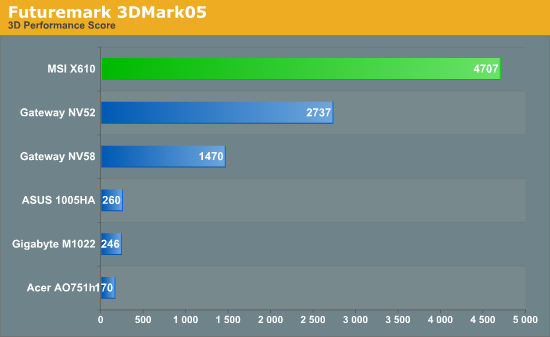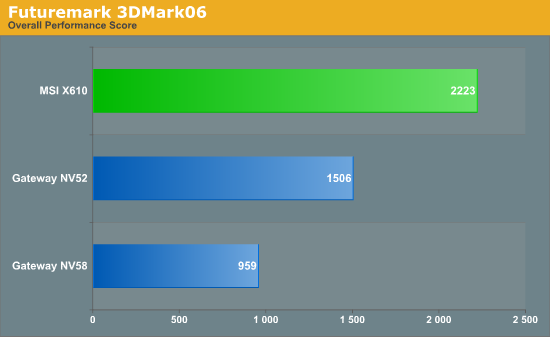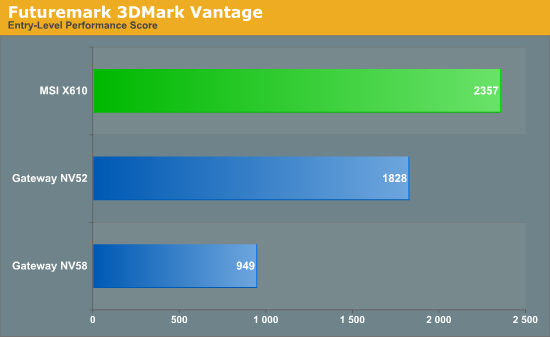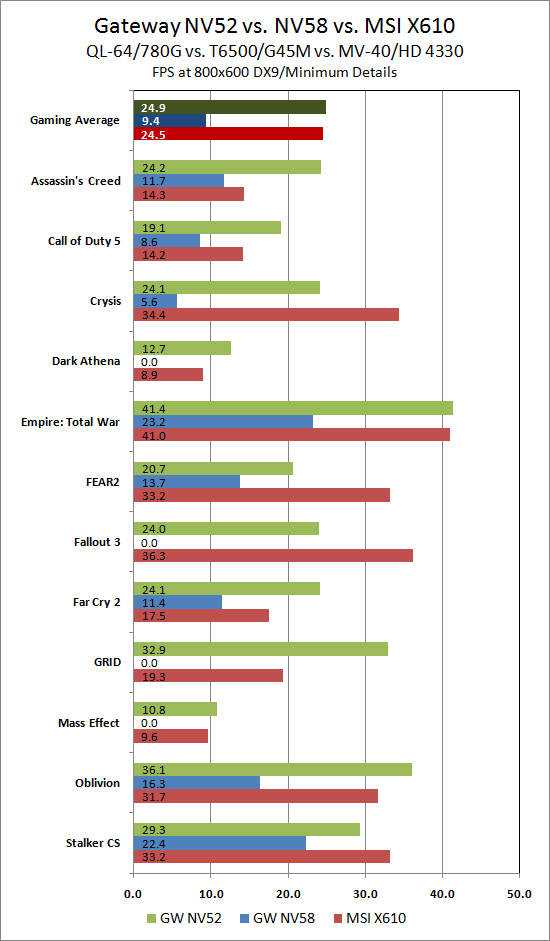MSI X610: Supersizing the Netbook?
by Jarred Walton on October 6, 2009 10:00 PM EST- Posted in
- Laptops
X610 Gaming and Graphics Performance
Since the MSI X610 includes a discrete GPU, discussing gaming performance is relevant. We will include the netbooks in the 3DMark results, but it should come as no surprise that even the fastest netbook is clearly outclassed for the time being. 3DMark also tends to put more of an emphasis on the GPU -- especially in some of the older versions -- so it's interesting to see how the HD 4330 compares against the HD 3200 in such testing. Unfortunately, actual gaming often depends a lot more on balancing CPU and GPU performance; as we will see, there are several instances where the AMD Neo MV-40 is simply unable to run certain games adequately, even at minimum detail settings. A faster dual-core chip would have gone a long way towards solving that problem.




Starting with the 3DMark results, the MSI X610 initially looks like a very promising gaming solution. It's over twice as fast as the NV52 in 3DMark03… but then it's 72% faster in 3DMark05, 48% faster in 3DMark06, and only 29% faster in 3DMark Vantage. That means that the newer the benchmark, the less the advantage for the X610. We all know that the 3DMark suites are not necessarily games, but they do correlate to gaming performance in some instances. The real question is whether a game matches 3DMark03, 05, 06, or Vantage in the way it approaches graphics (or perhaps something in between). Let's move to the actual gaming performance results and see what the MSI X610 can do.

We already stated that there would be instances where the single-core MV-40 processor was inadequate for modern games, and the above chart shows at least six titles (out of 12) where the X610 is not able to provide adequate performance, even at minimum detail settings and an 800x600 resolution. Moreover, if we average the results from all 12 titles, we find that the Gateway NV52 and the MSI X610 are essentially equal.
We know from 3DMark that the theoretical performance of the HD 4330 is substantially higher than the HD 3200, but quite a few titles have the HD 3200 with QL-64 in the lead. There are two reasons for the higher performance from the QL-64. First, it has a clock speed that's 31% higher than the MV-40. That could account for the lead in some of the games, but it's also obvious that the second CPU core is coming into play on some titles. For instance, Assassin's Creed and GRID run 70% faster on the NV52. Call of Duty: World at War, Dark Athena, and Far Cry 2 have the NV52 leading by 35%, 43%, and 37% respectively, so they also appear to benefit slightly from the second CPU core.
Other titles don't require nearly as much CPU power, with the X610 coming out on top. The X610 leads by 43% in Crysis, 61% in FEAR2, 51% in Fallout 3, and 13% in STALKER: Clear Sky. Performance in most of the remaining titles is within 10%, although the NV52 leads in each case. The net result is that gaming is possible on the X610, but there are definitely limitations imposed by the MV-40 CPU.
We also ran some quick test of casual games like the Sims 2/3 and Spore. None of these titles has any difficulty running on the X610, with frame rates typically hitting the 30 FPS cap. There are also many titles where you can crank up the resolution and/or detail settings on the HD 4330 without lowering performance. Medium quality settings at 1366x768 only reached playable levels in Fallout 3 (27 FPS), but low-quality 1366x768 worked in Crysis (27 FPS), Empire: Total War (37 FPS), Fallout 3 (34 FPS), Oblivion (29 FPS), and STALKER: Clear Sky (28 FPS). World of WarCraft should also run reasonably well, although with me not being a subscriber (or interested in becoming one!) it wasn't something I tested. Considering people have run WoW on netbooks, the X610 should easily be up to the task.










41 Comments
View All Comments
AnnonymousCoward - Wednesday, October 7, 2009 - link
1366x768 sucks.You can get a Dell 15.6" 1600x900, dual core pentium T4200, 6-cell battery, with DVD drive for $514. Or with the HD4330 for $614. The X610 is $735. The Dell weighs 1.5 pounds more, though, so you'll need to hit the gym.
Mint - Wednesday, October 7, 2009 - link
That's a pretty big "though". 4.5 lbs is just about the limit for fairly comfortable portability, and comparing it to a 6 lb notebook is ludicrous.1366x768 on a 15.6" is similar pixel size to most desktop monitors, and 1440x900 isn't that much better yet it's the highest resolution you get in a 4.5 lb notebook, AFAIK. Compare it with the top rated notebooks at this weight, like the Timeline 4810 (same res) and MacBook Pro 13" (1280x800).
AnnonymousCoward - Wednesday, October 7, 2009 - link
Comparing 4.5 pounds to 6 pounds is ludicrous? If you're that picky about weight, you'd better go for a 2 pound netbook. I would gladly take the 1.5 pounds for the high res screen and fast CPU.gstrickler - Wednesday, October 7, 2009 - link
Actually, Dell lists it at 5.54 pounds with 6 cell battery and DVD drive. It's under 6 pounds no matter how you configure it. Yes, the extra pound will make a difference, but anything under 6 pounds is very portable.Certainly, the Dell Studio 15 sounds more interesting than the MSI X610, and I would like to see how a Dell Studio 15 and/or 13" MacBook compare in performance and battery life. The Dell has the Intel X4500HD IGP standard, offers HD4570 discrete GPU as an option. The MacBooks uses the Nvidia 9400M G chipset. Both IGPs are slower than the HD4330, but they're not terrible and they use a lot less power. Both use C2D (the Dell base price has the dual core Pentium T4200, which is a C2D with less cache and slower FSB, but that's still a big step up from a single core 1.6GHz Athlon).
Mint - Thursday, October 8, 2009 - link
The market has proven both of you wrong for many years now. Why do you think Vaios and Lifebooks cost so much? Or why Apple charges more for the Air than the Pro 13"? Why do you think the M1330 was such a hit, despite costing much more than 15" Dells? Why do you think the X60/X200/X300 Thinkpads sell for so much more than 15" Thinkpads?5 lbs really is where it starts getting uncomfortable for the majority of people. 4 lbs is nice, 3 lbs is desireable. Netbooks took off when they weren't any cheaper than much faster value notebooks.
sxr7171 - Friday, October 9, 2009 - link
Ha Ha, that's what I was thinking the whole time reading this article. I'm sitting here with a 2.4lb Thinkpad X200s laughing in my head wondering about in what parallel universe would a 4.5lb laptop be considered light.This thing weighs 2.4lbs and packs a Core 2 Duo. There is no way they will allow these "netbooks" to cannibalize the sales of ultraportables hence the awkward netbook form factors as this machine. The only netbook that could even tempt me is the 1.4lb Vaio-P or actually now the Vaio-X. There could not possibly be a better machine made for surfing the internet while lying on the couch.
Also that Dell E4200 - great specs, nice 2.2lb weight.
Mint - Saturday, October 10, 2009 - link
If you're laughing at me, then what do you think about the guys that I replied to who are suggesting a 6lb notebook is light enough and comparable to this?Regardless of screen size, you can rarely get more than 1366x768 in a 4.5lb notebook for less than twice the price. No Apples, only two Dells (the 14z's), no IdeaPads (Thinkpads are way too expensive), etc.
AnnonymousCoward - Thursday, October 8, 2009 - link
I don't really understand your last sentence. I think netbooks took off since they were dirt cheap and ultra portable.Weight-aside, at 15.6", 1600x900 is a must.
Bull Dog - Wednesday, October 7, 2009 - link
I recently owned a MSI GT735 laptop and it too had the integrated GPU disabled. On the other hand, my family has a couple of old Asus laptops with 2.0GHz Turion 64 X2 CPUs and Mobility Radeon 2600 GPUs and x1250 integrated graphics and Asus gave users to option in the bios to switch between the two. And this was long before AMD was talking about doing this.Additionally the 1366x768 LCD screens are just fail. 800 vertical pixels is bad enough, now I'm supposed to step down to 768? No thank you. Why didn't MSI include AMD's dual core Athlon x2 Neo cpu instead? Probably cost reasons but it would have made the laptop far more convincing. Personally, I'm loving my HP dvz2.
dingetje - Wednesday, October 7, 2009 - link
"If MSI could keep the price close to $500 (€500)"eh, 500 Euro is about 735 US Dollar ... oops?